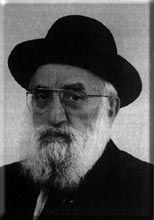Beit Midrash
- Torah Portion and Tanach
- D'varim
- Ki Tavo
- Shabbat and Holidays
- The High Holidays
- S'lichot
Answer:
From the beginning of Selichos, continuing with the closing sentences of the haftarah we recite on Shabbos Shuvah, and then again after Maftir Yonah, and climaxing with the Selichos we recite in ne'ilah, we repeatedly enumerate or allude to the thirteen attributes of Hashem's kindness. The words mi keil kamochaalso allude to the thirteen attributes of Hashem's kindness.
Why is the recital of the thirteen midos of Hashem's mercy so important? Allow me to quote the relevant Talmudic passage:
Rabbi Yochanan said: "Were it not for the fact that the Torah itself wrote this, it would be impossible to say this. The Torah teaches that Hashem wrapped Himself in a talis like a chazzan and demonstrated to Moshe the order of prayer. Hashem told Moshe: 'Whenever the Jews sin, they should perform this order, and I will forgive them"' (Rosh Hashanah 17b).
Rabbi Yochanan noted that the anthropomorphism of his own statement is rather shocking, and, without scriptural proof, we would refrain from saying it. Nevertheless, the Torah compelled us to say that Hashem revealed to Moshe a means whereby we can be pardoned for our iniquities. According to the Maharal, Moshe asked Hashem to elucidate, to the extent that a human can comprehend, how Hashem deals with the world in mercy. Hashem did, indeed, enlighten Moshe, and this enabled him to implore that the Jewish people be forgiven and taught him how to lead the Jews in their prayers (Chiddushei Agados, Rosh Hashanah 17b s.v. Melameid).
Source for Selichos
This, then, is the basis for Selichos. Indeed, it is not a takanah, but a custom; yet, who would not avail himself of the opportunity to prepare early for this chance? To quote the Leket Yosher: Someone who goes to daven on the High Holidays and did not say Selichos in preparation can be compared to an individual who desires to approach the king with an urgent request, and manages to acquire the key to the king's inner sanctum, but fails to arrange how he will enter the outer office. All his efforts are therefore completely in vain, because he failed to prepare himself adequately. This can be compared to someone moving to an unsettled area who installs a modern kitchen, expecting to be able to turn on the tap and produce water, when there are no connecting water pipes!
A Word about Attributes
What, exactly, are the thirteen attributes? For that matter, can we attribute personality characteristics to Hashem?
Humans are not capable of understanding who Hashem is. The Torah requires that we understand that Hashem does not have moods (Rambam, Hilchos Yesodei HaTorah 1:11). When we describe Hashem's different attributes, we are explaining Hashem in a way that we, as human beings, will be able to comprehend Him, since we cannot comprehend Him in any other way (Rambam, Hilchos Yesodei HaTorah 1:9). Thus, providing thirteen different attributes of Hashem's mercy is simply a human way for us to appreciate more specifically and to a greater extent what Hashem does and has done for us, and what is our responsibility to fulfill the mitzvah of being like Hashem, which I will explain shortly.
To quote Rabbeinu Bachyei: Although we no longer know how to beseech nor do we properly understand the power of the thirteen attributes, and how they connect to Hashem's mercy, we still know that the attributes of mercy plead on our behalf, since this is what Hashem promised. Today, when we are without a kohein gadol to atone for our sins and without a mizbei'ach on which to offer korbanos and no Beis Hamikdash in which to pray, we have left only our prayers and these thirteen attributes (Kad Hakemach, Kippurim 2).
Who Knows Thirteen?
To quote the Haggadah, "I know thirteen! Thirteen are the attributes."
What are the thirteen midos?
The Torah says: Hashem, Hashem, Who is a merciful and gracious G-d, slow to anger, and abundant in kindness and truth. He preserves kindness for thousands of generations by forgiving sins, whether they are intentional, rebellious or negligent; and He exonerates (Shemos 34:6-7).
There are many opinions among the commentaries and the halachic authorities exactly how to calculate the thirteen merciful attributes of Hashem. The most commonly quoted approach is that of Rabbeinu Tam, who includes each of the Names of Hashem at the beginning as a separate attribute (Tosafos, Rosh Hashanah 17b).
What do I do?
At this point, I want to return to the above-quoted Talmudic source of the Selichos and note an important point.
Hashem told Moshe: "Whenever the Jews sin, they should perform this order and I will forgive them." The Hebrew word that I have translated as should perform this order is yaasu, which means that the Jews must do something, definitely more than just reciting the words. If all that is required is reading the words, the Gemara should have said simply: They should read these words. Obviously, action, which always speaks louder than words, is required to fulfill these instructions and accomplish atonement. What does the Gemara mean?
Emulate Hashem
To answer this question, we need to realize that the most important of the 613 mitzvos is the commandment to emulate Hashem. To quote the Gemara: Just as Hashem is gracious and merciful, so should you become gracious and merciful (Shabbos 133b). When Hashem told Moshe: Whenever the Jews perform this order, I will forgive them, He meant that when we act towards one another with the same qualities of rachamim that Hashem does, He forgives us. Reciting the thirteen attributes of Hashem's mercy is the first step towards making ourselves merciful people who emulate Hashem's ways. Yaasu means learning to internalize these attributes by doing them, and thereby making ourselves G-dly people. "Doing" the thirteen attributes means not only understanding the absolutely incredible amount of tolerance that Hashem manifests, but includes, also, realizing how accepting we must be of people who annoy and harm us!
This sounds great in theory. What does it mean in practice?
Here are several examples, all taken from the sefer Tomer Devorah, to help us comprehend what our job is:
1. Whenever someone does something wrong toward Hashem, at that very moment He provides all the needs of the offender. This is a tremendous amount of forbearance that Hashem demonstrates. Our mitzvah is to train ourselves to be accepting, to this great extent, of those who annoy and wrong us.
2. We should appreciate the extent to which Hashem considers the Jews to be His people; we should identify with the needs of each Jew on a corresponding level.
3. Hashem waits with infinite patience for the sinner to do teshuvah, always being confident in this person's ability to repent and change, and continues to provide the sinner with all his needs. Similarly, we should not stand on ceremony to wait for someone who wronged us to apologize.
4. Hashem emphasizes the positive acts that a person does and continues to shower the person with good, while, in the interim, He overlooks the sins a person has performed. Similarly, when I know that someone wronged me, but at the same time I have received chesed from him or her, I should ignore the fact that they wronged me – after all, they have also helped me. The Tomer Devorah emphasizes specifically the chesed that one receives from one's spouse, which should, without question, supplant any criticisms one has of him or her.
5. When a person does teshuvah after sinning, Hashem loves him more than He loved him before he sinned. As the Gemara states: In a place where baalei teshuvah stand, complete tzadikim are unable to stand. The parallel responsibility incumbent on a person to someone who wronged him is that when he sees that the person wants to makes amends, he should befriend and accept him at a greater level than he had previously.
We see that the recital of the thirteen attributes serves not only to help us appreciate all that Hashem does for us, but also as a training ground to teach how we should constantly treat our fellowman.
Conclusion
My rosh yeshivah, Rav Yaakov Ruderman zt"l asked, Why do Ashkenazim not begin reciting Selichos until at most eight days before Rosh Hashanah? The custom of the Sefardim, who begin reciting selichos at the beginning of Elul, seems to make more sense. After all, the entire month is specially designated for doing teshuvah.
His answer was that proper prayer requires hachanah, proper preparation. We need the beginning of Elul to get prepared for properly reciting the Selichos (Sichos Avodas Halevi pg. 264). Now that we understand how much of a responsibility we are assuming when we recite the thirteen midos of Hashem, we can appreciate better why we need several weeks of preparation before we begin reciting the Selichos.
This Shiur is published also at Rabbi Kaganof's site

Parashat Hashavua: Publicizing those who Perform Mitzvot
Rabbi Yossef Carmel | 13 Elul 5783

Even the Wicked are Important
Rabbi Yossef Carmel | Elul 19 5779

Bikurim - a Lesson for the Year
Parshat Ki Tavo
Rabbi Ron Klopstock | Elul 5761





















